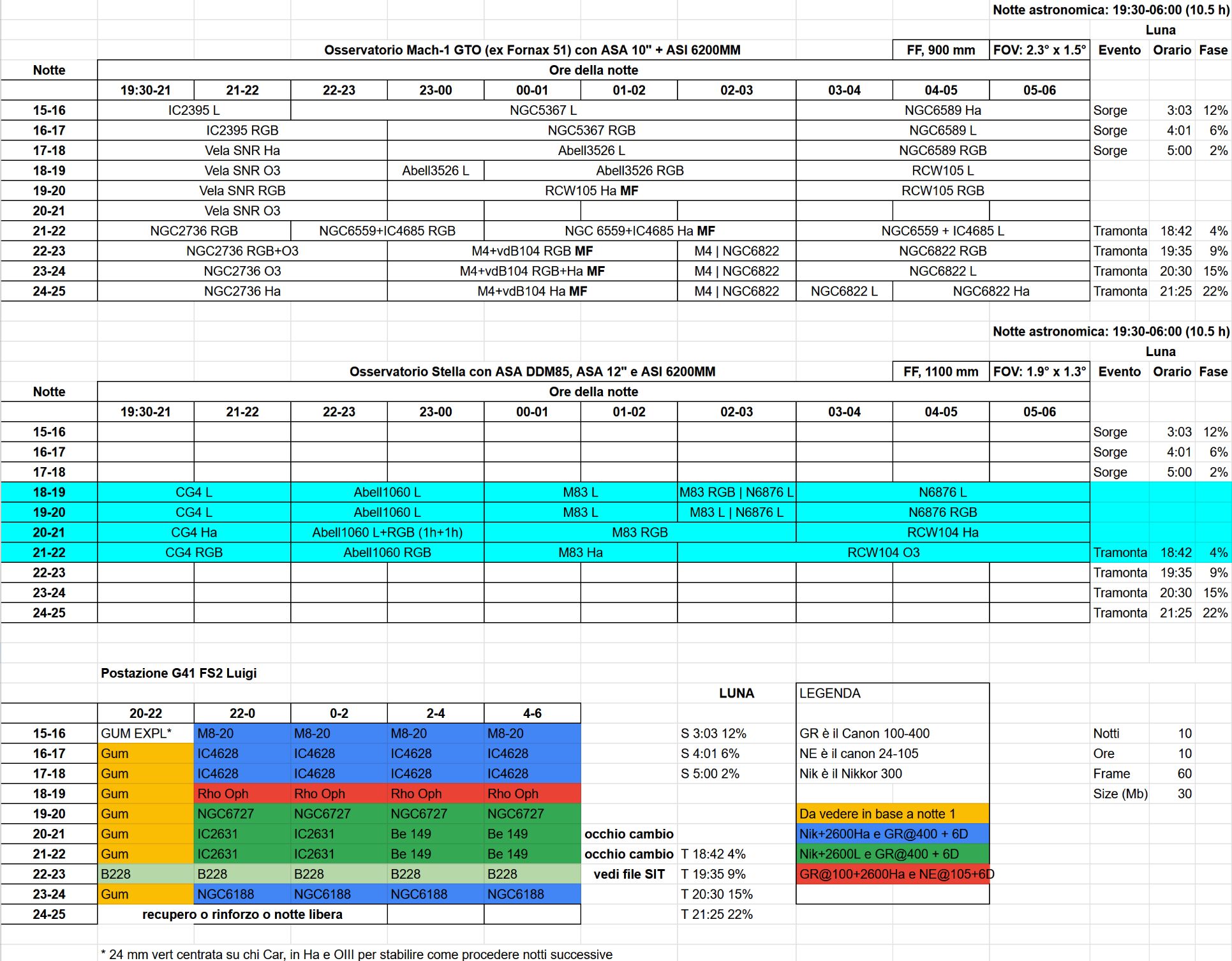Albeit long overdue, I’m sharing with you my adventure of May 2023, when I traveled to Namibia (namely to Tivoli Farm, as usual) to observe and image the gems of the southern sky.
This time around too I opted to travel in May, which marks the start of the dry season and sports weather generally stable enough to justify such a demanding and expensive trip, along with the bonus of offering good observing conditions for the autumn constellations of the southern hemisphere: Puppis, Carina, Vela, etc. This was my second trip in this time of the year, the first one having taken place in May 2021. On my two first trips (2011 and 2019) I had travelled in July and August, that is in the heart of the dry season, which is also the time of the year normally providing the most stable weather patterns.
My travel buddies were two very good friends of mine: Luigi Fontana (who also joined me in 2011 and 2019) and Alessandra Bruzzi, a long-time avid amateur astronomer, fellow member of the Urania astronomy club of Genoa (Italy) like myself and the only of us boasting a real astronomy degree.
The period chosen was centered around May 2023’s Full Moon (22 May) with our stay planned from 15 to 25 May, departing from Italy on May 14 and arriving on the 15, and returning on the 25 with an overnight flight arriving in Italy on the 26. We flew both journeys with Lufthansa/Eurowings Discover from Milan with a layover in Frankfurt.
At Tivoli Farm, we rented an array of setups to cover a wide focal length range, from relatively narrow to wide-field. In particular:
|
Setup |
Mount | OTA | Camera | Sensor size |
Field (degs) |
| Widefield | Losmandy G11 + FS2 | Nikon 300 f/2.8 ED tele lens | ASI 2600MM + Baader filters | 23.5 x 15.7 mm (26 Mp) | 4.49 x 3.00 |
| ASA 10” | AP Mach1 GTO | 10” ASA f/3.6 (900 mm) | ASI 6200MM + Baader filters | 36.0 x 24.0 mm (61 Mp) | 2.29 x 1.53 |
| ASA 12” | ASA DDM85 | 12” ASA f/3.6 (1080 mm) | ASI 6200MM + Baader filters | 36.0 x 24.0 mm (61 Mp) | 1.91 x 1.27 |
| Samyang 135 | SW Star Adventurer | 135 mm f/2 Samyang tele lens | ASI 071 MC Pro | 23.6 x 15.6 | 10.0 x 6.6 |
Photos acquired with the first two setups on the list are joint work of Luigi and myself, while the others were an initiative of my own. This is reflected in the credits for each image.
Our rig is complemented by a Skywatcher Star Adventurer sky tracker of ours, plus some fixed tripods and camera for landscape photography and, as the icing on the cake, we also rented a 20” dobsonian for visual observing. We had a very dense photo and observing program, and I can assure that managing that arsenal of telescopes is no easy feat and calls for meticulous planning!
Luigi and I split our tasks as follows: he was in charge of the wide-field setup with the Losmandy G11, while I operated the two astrographs and Alessandra kept herself busy mostly with visual observation with the dobsonian, this being her first time ever under the southern sky.
The figure below gives an idea of our dense imaging plan. To be sincere, we did experience glitches and problems which, however, didn’t prevent us from pulling off nice shots and having a rewarding experience and lovely memories.

The weather was our #1 foe. The period leading up to our trip (most of April and early May 2023) had been marked by unusually unstable weather, with abundant cloud and above-average precipitation. Unfortunately, this trend also continued on the first two nights of our stay (15-16 and 16-17 May) which were ruined by cloudy skies and showers, one of which started early in the night, with our observatories open and ready for imaging. This had us rushing like crazy to close the roofs and shelter our delicate rigs!
Luckily enough, the weather got more stable over the following days, granting us eight clear nights, although with high relative humidity (quite unusual for a desert) and poor seeing conditions at times, which can be a problem when using larger aperture scopes. Anyway, a cloudy night in the Kalahari desert is quite an experience in itself: when the sky is clear, it’s already amazingly dark but starglow illuminates the scene, especially if the Milky Way is high up in the sky; but if it’s overcast, even the stars’ dim light is cut off and it gets pitch-dark beyond imagination!
As cramming our photos and experiences into one single post would have made it too long and perhaps even tedious, I decided to split it into several articles. This is the first of the series and here I’ll discuss the details of the photos acquired with the 10” ASA astrograph.
As already mentioned, I mainly kept myself busy with the two longer focal length setups, including the 10-inch ASA astrograph having a focal ratio of f/3.6 and a focal length of 900 mm coupled with Luigi’s ASI 6200MM camera, which yielded a field of view 2.3 x 1.5 degrees across and an image scale of 0.86 arcsec/pixel. The ASA astrograph was mounted on an AP Mach1 GTO mount in the Aquarius observatory, which used to house a less sophisticated, but by no means less effective, Fornax 51 mount until 2020 or 2021. I had first used this observatory on my first trip to Tivoli Farm back in 2011.
One point to consider is that upon each trip to Namibia new “variables” come into play:
The targets in the table below were imaged with the 10” ASA and Luigi’s ASI 6200MM. Exposure times are “net”, in that they include only subframes good enough to be processed, after throwing away all defective ones (e.g. because of guiding errors).
|
Object |
Type | Constellation | Exp/filters (min) |
Total exp. |
| Abell 3526 | Galaxy cluster | Centaurus | L: 26 x 10 m
R: 5 x 10 m G: 5 x 10 m B: 4 x 10 m |
400 min = 6h 40m |
| Messier 4 + Sigma Sco (Alniyat) | Globular cluster + emission nebula | Scorpius | H-alfa: 22 x 10 m
R: 15 x 10 m G: 16 x 10 m B: 15 x 10 m |
680 min = 11h 20m |
| NGC 2736 | Supernova remnant | Vela | H-alfa: 8 x 10 m
OIII: 27 x 10 m R: 9 x 10 m G: 8 x 10 m B: 7 x 10 m |
590 min = 9h 50m |
| NGC 5367 | Reflection nebula | Centaurus | L: 28 x 10 m
R: 4 x 10 m G: 4 x 10 m B: 3 x 10 m |
390 min = 6h 30 m |
| NGC 6559 | Emission nebula + dark nebulae | Sagittario | L: 14 x 10 m
R: 4 x 10 m G: 3 x 10 m B: 3 x 10 m |
240 min = 4 h |
| RCW 105 (aka Gum 51 | Emission nebula | Norma | H-alfa: 16 x 10 m
R: 9 x 10 m G: 9 x 10 m B: 8 x 10 m |
420 min = 7 h |
| Vela SNR | Supernova remnant | Vela | H-alfa: 16 x 10 m
OIII: 36 x 10 m R: 7 x 10 m G: 7 x 10 m B: 5 x 10 m |
710 min = 11h 50m |
Only with this setup, close to a total of 60 hours of exposure time was acquired.
The pool of targets chosen is quite varied. The “star” of the group was the Vela supernova remnant, which I had long been planning to image at quite high resolution, after having taken a wide-field mosaic in 2021. The following paragraphs provide a short description of the objects before displaying the actual photos.
Abell 3526 is a galaxy cluster in Centaurus about 170 million light years away, whose brightest member is NGC 4696, an elliptical galaxy shining at about magnitude 11. Among the dozens of galaxies that can be spotted in the field, worth mentioning is NGC 4650, a beautiful barred spiral galaxy, next to which is NGC 4650A (PGC 42951), a polar-ring galaxy, featuring an oblong nucleus and a ring of young stars crossing the nucleus’s poles. In the surroundings, NGC 4622A, a mixed elliptical-spiral galaxy (PGC 42852 and 42845) can also be spotted.
Messier 4 is a globular cluster and Sigma Scorpii (Alniyat) is a star surrounded by a beautiful mixed reflection/emission nebula (SH2-9 and LBN 1101, 1105 and 1106). Both M4 and Alniyat are part of the Rho Ophiuchi region. This area of the sky, straddling the border between Scorpius and Ophiuchus, also comprises Antares, Scorpius’s brightest star, is a popular wide-field target and is also visible from mid-northern latitudes, albeit very low above the horizon.
The Vela SNR is a very wide (about 8 degrees in diameter) supernova remnant in the constellation Vela. Located about 800 light years away, it’s the result of a supernova that went off about 11000 years ago, is one of Vela’s main features and is also home to a pulsar, the Vela Pulsar. Part of this nebular complex is NGC 2736, also known as the Pencil Nebula thanks to its unique shape.
NHC 5367 is a bright reflection nebula in the constellation Centaurus which includes the “cometary globule” CG12. Cometary globules, despite their name, have nothing to do with comets: rather, they are dense gas and dust clouds home to intense star formation. They owe their name to their vague resemblance to a comet, since they are made up of a denser area from which filaments seem to be projecting into one dominant direction like the tail of a comet.
RCW 105, also known as Gum 51, is an emission nebula in the constellation Norma. Despite featuring nice and complex structures, it is largely underrated.
NGC 6559 is a mixed emission-reflection nebula complex just east of the ubiquitous M 8, the Laguna Nebula. The framing was totally off, so it shouldn't count as a valid photo. Nevertheless, it didn’t come out too bad, so I’m throwing it in anyway 😊.
That’s all for the moment. Enjoy and stay tuned for more! 😃

Leave a comment